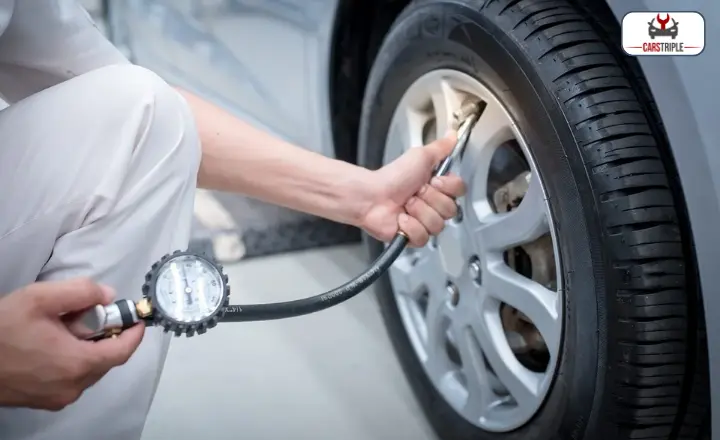The VSA Light Honda is like the check engine light for the vehicle’s stability control system, and its sudden appearance can be a disconcerting experience for any driver. It’s like an enigmatic signal flashing on the dashboard, leaving you wondering what could have gone wrong with your trusty Honda.
Whether you’re cruising down the highway or navigating through city streets, seeing that VSA light illuminate can evoke feelings of concern and uncertainty.
As modern vehicles become increasingly complex with advanced electronic systems, understanding what triggers a specific warning light to illuminate has become a crucial part of car ownership. The VSA (Vehicle Stability Assist) light is no exception to this rule, as it serves as an important indicator of potential issues related to your Honda’s stability control system.
What Is The VSA Light Honda?
The VSA system, or Vehicle Stability Assist, is a crucial safety feature found in Honda vehicles. This innovative system utilizes sensors to monitor the vehicle’s stability and traction. When it detects skidding or loss of control, the VSA system kicks in to apply selective braking and reduce engine power, thereby helping the driver regain control.
The VSA system is its ability to work in conjunction with other safety features, such as ABS and traction control. This integration ensures that the vehicle maintains stability and grip on various road surfaces, enhancing overall driving confidence and safety.
It’s worth noting that if the VSA light comes on in your Honda, it could indicate a problem with the system that needs to be addressed promptly for optimum performance.
The Honda vehicles represent a remarkable advancement in automotive safety technology. Its role in preventing accidents by aiding drivers to maintain control during challenging driving conditions cannot be overstated. As vehicle safety continues to evolve, it’s clear that systems like VSA will continue to play a pivotal role in making driving safer for everyone on the road.
VSA Symbol On The Dashboard
When you see the VSA symbol light up on your Honda’s dashboard, it’s essential to understand its significance. The Vehicle Stability Assist (VSA) system is a crucial safety feature that helps maintain control during sudden maneuvers or slippery road conditions.

When the VSA light comes on, it could indicate a problem with the system that requires attention. The VSA light is illuminating because of a faulty sensor or an issue with the system’s calibration. It’s important not to ignore this warning, as it could affect your vehicle’s overall stability and handling.
If you notice the VSA light staying on consistently, it’s best to have your Honda inspected by a qualified mechanic who can diagnose and resolve any underlying issues.
What Causes The VSA Light To Come On?
When the VSA (Vehicle Stability Assist) light comes on in your Honda, it can be a signal of various issues that need attention. One common cause of the VSA light is a problem with the wheel speed sensors.
These sensors are responsible for monitoring the speed of each wheel and sending data to the VSA system to help maintain vehicle stability. If these sensors are damaged or malfunctioning, it can trigger the VSA light to come on.
Another possible culprit behind the VSA light coming on is a fault in the ABS (anti-lock braking system) module.
The ABS module works in conjunction with the VSA system to ensure smooth and controlled braking, especially during sudden stops or slippery conditions. If there is an issue with the ABS module, it can lead to the activation of the VSA light as a warning sign.
1. Unreliable Components
Unreliable components can wreak havoc on any system, leaving users frustrated and dissatisfied. From malfunctioning sensors to faulty wiring, these elements contribute to the all-too-common experience of system breakdowns.
The most frustrating aspect is that unreliable components often fail without warning, leading to unexpected issues and costly repairs. One key contributor to this unreliability is the lack of regular maintenance and proper care, which can allow small problems to escalate into major headaches.
Environmental factors such as extreme temperatures and excessive moisture can also play a role in causing components to become less reliable over time.
Poor-quality materials or manufacturing defects may lead to premature component failure, affecting the overall performance of a system. Understanding these root causes can help users take proactive measures to address reliability concerns before they escalate into serious problems.
2. Tire pressure is too low
Tire pressure that is too low should not be taken lightly. Not only does it lead to decreased fuel efficiency and uneven tire wear, but it also compromises the overall safety and handling of the vehicle.

Low tire pressure can result in increased stopping distances, reduced grip on the road, and an increased risk of blowouts or flats. It can trigger various warning lights on your dashboard, including the VSA light.
3. Faulty tires
Faulty tires can be a serious hazard on the road, causing unexpected blowouts, loss of traction, and even accidents. There are various factors that can lead to tire faults, such as underinflation, overloading, poor maintenance, and aging.
Underinflated tires can increase fuel consumption and reduce stability while driving, affecting the vehicle’s overall performance. Overloading a vehicle puts excessive pressure on the tires, leading to faster wear and tear.
Poor maintenance practices, like failing to regularly check tire pressure or ignoring signs of wear and tear, can result in dangerous situations on the road. As tires age, their rubber degrades, which could lead to cracks and weakening of its structure.
4. Switch Turned Off
This indicator can be a signal that something isn’t quite right with your vehicle’s stability and traction control systems. There are several potential reasons for this warning light to illuminate, ranging from simple issues to more complex problems.
The VSA light coming on is a malfunctioning wheel speed sensor. These sensors are responsible for detecting the rotational speed of each wheel and transmitting this information to the vehicle’s electronic control unit.
If one or more sensors fail or become damaged, it can trigger the VSA warning light. A faulty brake system, low tire pressure, or even a misaligned steering angle sensor can also cause the VSA light to come on.
- Understanding these potential causes can help drivers better diagnose and address issues related to their vehicle’s stability control system.
- By staying vigilant to these signs, you can address any underlying problems promptly and ensure your car’s safety systems are functioning optimally.
- Remember, safety should always be a top priority when it comes to maintaining your vehicle.
Is It Safe To Drive With The VSA Light On?
The VSA (Vehicle Stability Assist) light illuminates on your dashboard, it’s essential to address the issue promptly. While the VSA system is designed to enhance vehicle stability and traction control, driving with the VSA light on can pose potential safety risks.

- Driving with the VSA (Vehicle Stability Assist) light on can be risky, as it indicates a problem with the vehicle’s stability control system. This system is designed to help maintain traction and stability during sudden maneuvers or in slippery road conditions, making it crucial for safe driving.
- While some drivers may ignore the VSA light and continue driving, this could lead to compromised vehicle control, especially during emergencies or adverse weather conditions. It’s important to address the underlying issue causing the VSA warning light to ensure optimal safety on the road.
- Neglecting the VSA light could result in reduced braking performance, an increased risk of skidding or loss of control, and potential damage to other components of the vehicle’s safety systems.
What To Do When The VSA Light Comes On
In most cases, when the VSA light comes on, there’s usually no need to take any action. Essentially, it means that the VSA system is active and functioning. If this light comes on along with other warning lights, it’s important to have both systems checked out.
If the VSA and VSA indicator lights come on, it’s necessary to stop when safe and restart the engine. Honda owners can easily reset the VSA light themselves, as it’s a simple process.
To resolve the issue with the VSA light in your Honda, you should first ensure that the VSA button wasn’t accidentally pressed and also check that all tires have the correct pressure. Running a diagnostic scanner to check for trouble codes is essential for further diagnosis.

1. Check out Professional Mechanic
When you see the VSA (Vehicle Stability Assist) light come on in your car, it can be a cause for concern. This handy feature is designed to keep you safe and in control while driving, so when it’s not working properly, it’s important to take action.
The first thing to do when the VSA light comes on is to check your vehicle’s owner’s manual for specific guidance. It could be something as simple as recalibrating the system or resetting the sensors.
If that doesn’t resolve the issue, it’s time to bring your car to a professional mechanic who understands modern vehicle stability systems inside and out. They will have access to specialized diagnostic equipment that can pinpoint exactly what is causing the VSA light to turn on and provide informed solutions.
2. Fix Faulty Wiring or Connectivity
The most common reason for the VSA light coming on is faulty wiring or connectivity in the vehicle’s stability control system. This can lead to issues with traction control, stability assistance, and even braking performance.
When faced with this situation, it’s crucial to address the faulty wiring or connectivity promptly to ensure safe and reliable vehicle operation. Ignoring these issues could lead to further damage to essential safety systems and compromise your driving experience.
Seeking professional help from a certified mechanic or technician is highly recommended. They can diagnose the problem accurately with specialized equipment and expertise, ensuring that any faulty wiring or connectivity issues are resolved effectively.
3. Changing the wheel speed sensor
The common cause for this warning is a faulty wheel speed sensor. When this happens, it’s important to address the issue promptly as it can affect the stability and traction control of your vehicle. Changing the wheel speed sensor may seem like a daunting task, but with some basic tools and mechanical know-how, it can be done at home.
Identify which wheel speed sensor needs replacing by using an OBD-II scanner to read the specific error code. Once you’ve located the faulty sensor, remove the old one by disconnecting any electrical connectors and unscrewing it from its housing.
Take note of its position and orientation as you install the new wheel speed sensor to ensure accurate placement. After securing the new sensor in place, reconnect any electrical connections and clear any error codes using the OBD-II scanner.
4. Sensor for Steering Angle: Reset or Replace
When the VSA light comes on in your vehicle, it could be an indication of issues with the sensor for steering angle. This crucial element is responsible for ensuring that your vehicle’s stability control system operates effectively, allowing for safe and controlled driving experiences.
Before considering replacing the steering angle sensor, it’s important to try resetting it first. Often, a simple recalibration or reinitialization process can rectify minor issues and restore proper functionality.
This can be done through a diagnostic tool or by following specific instructions outlined in your vehicle’s manual. By attempting a reset first, you may save time and money compared to opting for a replacement right away.
If resetting the sensor does not resolve the VSA light issue, then it may be necessary to consider replacing the steering angle sensor altogether. Consulting with a qualified technician is essential to accurately diagnose any underlying problems before making this decision.
5. Scan Codes
Scan codes play a crucial role in diagnosing the root cause of issues when the VSA (Vehicle Stability Assist) light comes on. The scan codes are retrieved using an OBD-II scanner; it is vital to interpret them accurately to address underlying issues effectively. Understanding these codes empowers car owners to make informed decisions about necessary repairs and maintenance.

By taking proactive measures based on scan code results, car owners can avoid more extensive and costly repairs down the line. Embracing this approach to vehicle diagnostics helps ensure optimal performance and safety on the road while also extending the lifespan of their vehicles.
6. Inflate and check tire pressure
The Vehicle Stability Assist (VSA) light indicates an issue with your vehicle’s traction control system, which could be caused by a variety of reasons, such as low tire pressure. Your next step is to pull over at a safe location and check your tire pressure.
Properly inflated tires not only ensure smooth driving but also contribute to the proper functioning of your vehicle’s stability systems. Now that you have reached a safe spot, it’s time to roll up your sleeves and get down to business.
Grab a reliable tire pressure gauge and start checking each tire methodically. Pay attention not only to the readings but also to any signs of wear or damage on the tires themselves.
Once you’ve ensured that all four tires are properly inflated and in good condition, restart your vehicle and see if the VSA light has turned off. Sometimes solving this issue can be as simple as ensuring optimal tire pressure!
7. On/Off Switch
The On-Off switch is a simple yet powerful mechanism that controls the flow of power in various electronic devices. It symbolizes the ability to control, to start or stop, and to define boundaries.
In our fast-paced lives, finding our own on-off switch becomes crucial for maintaining balance and managing stress. Knowing when to switch off from work and engage in self-care activities is essential for preserving mental and emotional well-being.
The VSA light in your car—seeing it come on can be a cause for concern. instead of panicking, consider it an opportunity to practice proactive vehicle maintenance. Start by checking tire pressure and tread wear, as these are linked to VSA functionality.
Next, get the vehicle’s stability system inspected at a reputable auto service center if you’re unable to resolve the issue yourself. Remember that taking prompt action can prevent potential accidents associated with compromised vehicle stability.
How Much Does It Cost To Fix The VSA System?
The on-off switch is a simple yet powerful mechanism that controls the flow of power in various electronic devices. It symbolizes the ability to control, to start or stop, and to define boundaries.
In our fast-paced lives, finding our on-off switch becomes crucial for maintaining balance and managing stress. Knowing when to switch off from work and engage in self-care activities is essential for preserving mental and emotional well-being.
When it comes to the VSA light in your car, seeing it come on can be a cause for concern. Instead of panicking, consider it an opportunity to practice proactive vehicle maintenance. Start by checking tire pressure and tread wear, as these are linked to VSA functionality.
Get the vehicle’s stability system inspected at a reputable auto service center if you’re unable to resolve the issue yourself. Remember that taking prompt action can prevent potential accidents associated with compromised vehicle stability..
Conclusion
The VSA Light Honda vehicles serve as a critical safety feature, designed to enhance vehicle stability and traction control. It provides drivers with added confidence and peace of mind while driving in various road conditions.
Understanding the significance of the VSA light and its functions can help drivers make informed decisions when it comes to maintaining their Honda vehicles. By paying attention to the VSA light and addressing any issues that may arise, drivers can ensure their safety on the road. Therefore, Honda owners need to stay proactive in monitoring their VSA system and seek professional help if necessary.
FAQS
What does the VSA light indicate on a Honda?
The Vehicle Stability Assist (VSA) light indicates an issue with the VSA system, which helps maintain stability and traction in your Honda.
Why is my VSA light staying on in my Honda?
The VSA light may stay on due to issues with the ABS sensors, low brake fluid, or a malfunction in the VSA system.
How do I reset the VSA Light Honda?
You can try resetting the VSA light by turning off the engine, restarting, and driving straight for at least 100 feet to recalibrate the system.

